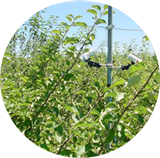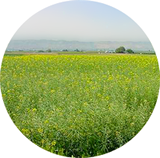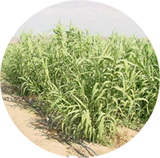Washington State University Irrigation Research
Irrigation automation using tree fruit canopy temperatures
 Previous studies have shown that canopy (leaf) temperature can be used as a good indication of crop stress. A plant pulls water up out of the soil and moves it out through the leaves where the water is transpired out of microscopic openings in the plant leaves called stomates. This cools the plant’s leaves. If the plant is water stressed, then it will close the stomates and restrict water loss and therefore the plant leaves will be relatively warmer than a non-stressed plant. The leaf temperature can be sensed remotely using infrared temperature sensors. These temperature signals have been used in row-crop plants to completely automate the irrigation system.
Previous studies have shown that canopy (leaf) temperature can be used as a good indication of crop stress. A plant pulls water up out of the soil and moves it out through the leaves where the water is transpired out of microscopic openings in the plant leaves called stomates. This cools the plant’s leaves. If the plant is water stressed, then it will close the stomates and restrict water loss and therefore the plant leaves will be relatively warmer than a non-stressed plant. The leaf temperature can be sensed remotely using infrared temperature sensors. These temperature signals have been used in row-crop plants to completely automate the irrigation system.
Researchers have found that this method is more responsive to plant stress than irrigating to replace soil moisture deficits based on measurements taken with a neutron probe soil moisture meter. Although it hasn’t been tried before on trees, the permanent nature of tree fruit and the typical irrigation systems used lend themselves to irrigation automation using infrared temperature sensors. We are currently testing this theory in a research block of Fuji apples on the Roza research farm. This research is being funded by the Washington Tree Fruit Research Commission.
Deficit irrigation of mint
 Some preliminary studies have suggested that equivalent, or even better, mint oil yields can be obtained for mint that is deficit irrigated. This could translate into greater profits for mint producers since they would have less hay to handle and put through the mint still while achieving equivalent or better oil yields.
Some preliminary studies have suggested that equivalent, or even better, mint oil yields can be obtained for mint that is deficit irrigated. This could translate into greater profits for mint producers since they would have less hay to handle and put through the mint still while achieving equivalent or better oil yields.
A study is being done where established mint is stressed at various irrigation levels, and the oil yields are taken and analyzed. The effects of this water stress on spider mite populations with different pesticide treatments as well as different weeds are also being looked at. This research is being funded by the Washington Mint Commission.
Water use requirements of irrigated canola
 The world’s demand for energy is escalating, while the supply of readily available oil has peaked and is now decreasing. We will need to supply our energy needs some other way. Biofuel crops show promise for partially supplying these needs. However, we don’t fully understand the impact that this will have on current agriculture and how this displacing of food production will affect the world.
The world’s demand for energy is escalating, while the supply of readily available oil has peaked and is now decreasing. We will need to supply our energy needs some other way. Biofuel crops show promise for partially supplying these needs. However, we don’t fully understand the impact that this will have on current agriculture and how this displacing of food production will affect the world.
Canola shows some promise as a future biofuels crop, but the water needs of this crop is not well understood and we don’t know if it makes sense to grow this crop under irrigation. We are investigating this by planting different varieties of canola and irrigating them at different levels. We will analyze the yields of these plots at different water application levels and determine the water use efficiency of these different levels to try to help answer the question as to whether it will be economical to grow this biofuel crop under irrigation in Washington State.
Water use requirements of irrigated Arundo Donox
 Biofuels can also be made from cellulosic crops such as straw and corn stalks. However, removing this residue from the soil has a negative impact on the soil. Alternate crops that produce large amounts of biomass are also being investigated.
Biofuels can also be made from cellulosic crops such as straw and corn stalks. However, removing this residue from the soil has a negative impact on the soil. Alternate crops that produce large amounts of biomass are also being investigated.
Arundo Donox is sometimes called Giant Reed. It produces large amounts of biomass and can also be used for making paper. It grows well in Washington, but the water use requirements are not well understood. As a part of an investigative study, we are also looking at the water use requirements of this crop.